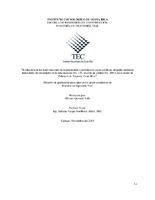Mostrar el registro sencillo del ítem
Evaluación de las intervenciones de mantenimiento periódico en capas asfálticas delgadas mediante indicadores de desempeño en la ruta nacional No. 135, sección de control No. 20811 en el sector de Palmares de Alajuela, Costa Rica
| dc.contributor.advisor | Vargas-Nordbeck, Adriana | es |
| dc.contributor.author | Quesada-Solís, Luis Alfonso | |
| dc.date.accessioned | 2016-03-15T17:44:58Z | |
| dc.date.available | 2016-03-15T17:44:58Z | |
| dc.date.issued | 2015 | |
| dc.identifier.uri | https://hdl.handle.net/2238/6390 | |
| dc.description | Proyecto de Graduación (Maestría en Ingeniería Vial) Instituto Técnologico de Costa Rica, Escuela de Ingeniería en Construcción, 2015. | es |
| dc.description.abstract | This project presents a technical, economic and statistical analysis of four typical periodic road maintenance activities used in Costa Rica, as defined in Law No. 7798, which were applied for thin asphalt overlays. The first activity consisted in patching before placing a 5 cm asphalt overlay. The second consisted of sealing cracks prior to a 5 cm asphalt overlay, the third consisted of a 5 cm asphalt overlay over the existing pavement and the last one implied milling 5 cm and placing a 5 cm asphalt overlay Every technique was applied on a homogeneous section located in the Control Section No. 20811 of National Road No. 135, between kilometers 5 + 210 to 6 + 810, chosen because, according to the geo-penetrating radar (GPR), it presented a similar typology type such as thickness of the pavement structure and a consistent state of the pavement surface, according to the Pavement Index Condition (PCI) analysis. The problem was that, in Costa Rica, there is no technical definition for optimizing periodic road maintenance interventions used to improve the structural and functional state of the national routes, which results in a deficiency investment in public works. The technical and economic assessment was to measure the values of evenness or comfort felt by users, defined by IRI indicator, and deflections of the pavement measured by the Falling Weight Deflectometer (FWD), together with the quality note “Q”, which represents a rating of the quality of the pavement. This work was performed before and after applied the four periodic road maintenance activities, in order to get the benefit assigned to each of them, using the percentage of improvement in road indicators along with the cost assigned to each activity. The statistical evaluation was concentrated on analysis "ANOVA + Tukey" and the test "paired t", with the intention of determining the consistency and validity of the data resulted of the vials indicators. It was evident that placing thin asphalt overlays showed no improvement in the structural conditions (deflection) of the section of research, because the cost-benefit ratios did not exceed 0,35 for the four activities, where from values of 1,00 can be considered positive results. However, it was shown that placing thin asphalt overlays did reveal an improvement in the operating conditions (IRI) of the section of research, because the cost-benefit ratios exceeded 1,25 and for the milling and asphalt overlay it reached 1,91, which demonstrate that it is the most efficient one in comparison with the other three periodic road maintenance activities. Finally, these findings establish that the milling pavement plus the thin asphalt overlay provide the best option for investment the state funds in periodic road maintenance in public works. Keywords Pavements, IRI, FWD, road maintenance techniques, overlay. | es |
| dc.description.sponsorship | Instituto Tecnológico de Costa Rica. EScuela de Ingeniería en Construcción. Ruta nacional No. 135. | es |
| dc.language.iso | es | es |
| dc.publisher | Instituto Tecnológico de Costa Rica | es |
| dc.rights | acceso abierto | es |
| dc.subject | Ruta Nacional No. 135 | es |
| dc.subject | Indicadores | es |
| dc.subject | Mantenimiento | es |
| dc.subject | Pavimento | es |
| dc.subject | Obras públicas | es |
| dc.title | Evaluación de las intervenciones de mantenimiento periódico en capas asfálticas delgadas mediante indicadores de desempeño en la ruta nacional No. 135, sección de control No. 20811 en el sector de Palmares de Alajuela, Costa Rica | es |
| dc.type | tesis de maestría | es |


